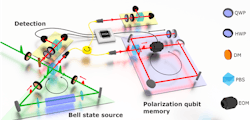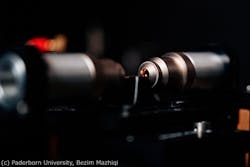Spooky action: First programmable all-optical quantum qubit memory
A collaboration between researchers at Paderborn University’s Integrated Quantum Optics group and Ulm University’s Institute of Theoretical Physics (both in Germany) is exploring using photons as quantum systems, and they recently came up with a new approach to entangle as many photons as possible in large states.
Why entangle as many photons as possible in large states? Multiphoton entangled states of light—think gigahertz states—enable quantum communication within networks and photonic quantum computation applications. But to successfully apply them for real-world applications, states of bigger size are needed.
An open question within the quantum community is how to solve the scalability limitation of quantum systems.
The team, led by Christine Silberhorn, a professor of physics who specializes in quantum optics at Paderborn, is probing the unique capabilities of time-multiplexed systems in combination with today’s engineered parametric down-conversion (PDC) sources—which generates two-photon states as basic ingredients. And her team’s all-optical polarization qubit memory combined with feed-forward operations zeroes in on the scalability challenge.
“From a conceptual point of view, we use the concept of multiplexing several probabilistic (quantum) PDC sources to achieve much higher generation rates, whereas an idealized system would produce deterministic sources,” says Silberhorn.
Silberhorn’s team generates states within the time domain via time multiplexing. In an experiment believed to be a first, they created an all-optical memory capable of storing photonics qubits with different polarization states rather than merely single photons (see video).
This requires three key ingredients: engineered integrated sources, an all-optical memory to store two different polarizations, and feed-forward operations.
“To generate appropriate input states, we use our highly efficient PDC sources based on waveguides, which are engineered for a single temporal mode—meaning these states can be seen as proper pulses,” she says.
Experimental setup
In the team’s experimental setup (see Fig. 1), a small quantum state can be stored until another state is generated, and then the two can be entangled. This enables a large entangled quantum state to be grown particle by particle.
How does it work? In their approach, Bell pairs are generated sequentially, and the detection of one photon triggers a feed-forward that uses a field-programmable gate array (FPGA) to control the operation mode of the all-optical storage loop.
They use a Ti:sapphire laser with a wavelength of 775 nm to pump a polarization Bell-state source based on PDC in a Sagnac configuration (ring interferometry; see Fig. 2). One photon of each emitted Bell pair gets detected and triggers the feed-forward, while the other photon gets sent to an all-optical storage loop and is stored until it’s brought to interference with the subsequent qubit.
Silberhorn’s team used this method to entangle six particles—and set a record for being more efficient than any previous experiments. The previous largest entanglement of photon pairs was by researchers in China, and consisted of 12 individual particles, but creating this state took orders of magnitude more time.
Their new approach can be combined with all common photon-pair sources, so other scientists can also use this method.
Challenges (you knew this was coming)
Scaling photonic quantum systems with probabilistic sources is difficult because, as Silberhorn puts it: “they naturally scale exponentially badly with system size.”
But combining an efficient polarization qubit storage device with feed-forward operations allows the researchers to gain a significant increase in generation rates and bring real-world applications of quantum protocols and algorithms within reach.
“The major challenge of our work was to design a storage device that works independent of the polarization of the incoming qubit, otherwise the entanglement process would be destroyed—and it’d never been implemented before,” says Silberhorn.
Tapping a Sagnac-like configuration allows both polarization components to travel around a loop clockwise or counterclockwise. And a fast-switching device (electro-optic modulator) dynamically switches between the different working modes of the memory upon a feed-forward signal from a preceding photon detection event.
“Upon detection of one partner of a generated Bell-pair, an electronic signal must be created, analyzed, sent to, and progressed by the electro-optical modulator (EOM) that defines the mode of the memory before the second photon arrives,” explains Silberhorn. “The switching speed of the EOM electronics needs to be around 5 nanoseconds—a task almost impossible with today’s technology.”
Applications ahead?
For secure quantum communication within network structures, multiphoton entangled states are the key to connect the different parties.
“There are several developments in the direction of quantum conference key agreement and multipartite key distribution showing that a composition of the well-known bipartite protocols is less efficient than new protocols based on multipartite entanglement,” says Silberhorn. “Our demonstration of time-multiplexing in combination with feed-forward also demonstrates important progress for quantum simulation and computation.”
Her team now has its sights set on generating even larger entangled states and creating new classes of multiphoton entangled states.
FURTHER READING
E. Meyer-Scott et al., Phys. Rev. Lett., 129, 150501 (Oct. 2022); https://doi.org/10.1103/physrevlett.129.150501.
About the Author
Sally Cole Johnson
Editor in Chief
Sally Cole Johnson, Laser Focus World’s editor in chief, is a science and technology journalist who specializes in physics and semiconductors.


